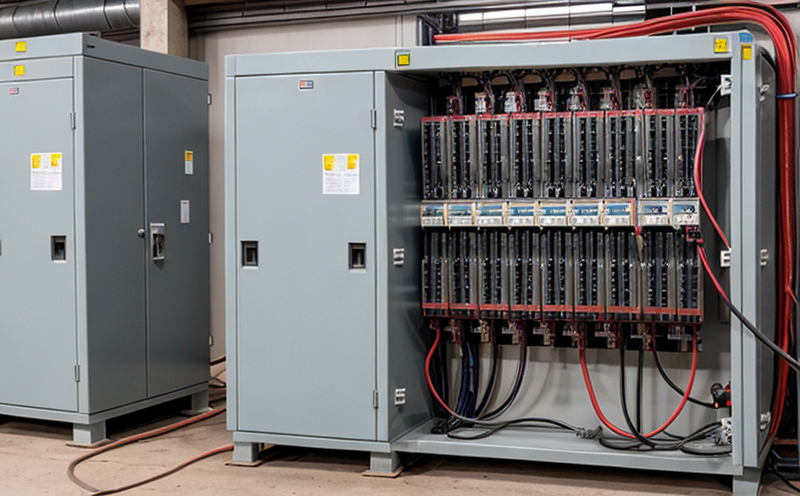EN 50160 Voltage Quality Testing of Transformers and Switchgear
The European standard EN 50160 specifies requirements for voltage quality in electricity supply networks, ensuring that the supplied voltage is within acceptable limits to meet users' expectations. This standard is crucial for power utilities and infrastructure companies to maintain reliable and efficient operations. When it comes to transformers and switchgear, these devices play a critical role in electrical distribution systems, making them key components in assessing compliance with EN 50160.
Transformer voltage regulation directly impacts the quality of electricity supplied to end-users. Transformers must be able to maintain stable voltages despite fluctuations in load conditions and ambient temperatures. This stability is essential for protecting sensitive electronic equipment and ensuring consistent power supply quality across various sectors such as manufacturing, healthcare, and data centers.
Switchgear contributes significantly to the safety and reliability of electrical systems by providing fault protection mechanisms like circuit breakers and disconnectors. Ensuring that switchgear operates within specified voltage parameters is critical for preventing equipment damage and ensuring continuous service delivery. Non-compliance with EN 50160 can lead to suboptimal performance, increased maintenance costs, and potential safety hazards.
The testing process involves measuring the primary and secondary voltages of transformers under different load conditions. The methodology aims to assess how well the transformer maintains voltage within specified tolerances as defined by EN 50160. This includes evaluating no-load and full-load conditions to understand the device's behavior under varying operational scenarios.
Switchgear testing focuses on verifying that the devices can withstand specified voltage levels during both normal operation and fault conditions. The standard provides detailed guidelines for determining acceptable deviations from nominal values, ensuring that switchgear performs reliably even when faced with challenging operating environments.
In addition to compliance testing, regular monitoring of transformers and switchgear is essential for proactive maintenance strategies. By continuously assessing voltage quality using EN 50160-compliant methods, utility operators can identify potential issues early on, reducing the risk of costly outages or failures. Furthermore, adhering to this standard helps utilities meet regulatory requirements set forth by national and international bodies.
Compliance with EN 50160 is not just about meeting legal obligations; it also contributes positively to brand reputation and customer satisfaction. By demonstrating commitment to delivering high-quality electrical services, power companies can build trust among their stakeholders while enhancing overall operational efficiency.
Scope and Methodology
The scope of EN 50160 voltage quality testing encompasses the evaluation of both transformers and switchgear within electrical distribution networks. The primary objective is to ensure that these components operate efficiently and consistently, delivering electricity at specified voltage levels.
For transformers, key parameters include:
- No-load losses
- Full-load losses
- Voltage regulation
- Thermal stability
The methodology involves conducting tests under controlled laboratory environments to simulate real-world operating conditions. This includes measuring primary and secondary voltages across different load points, tracking temperature changes, and monitoring energy consumption.
Switchgear testing covers:
- Breaking capacity
- Interrupting capability
- Insulation integrity
- Operating cycle performance
The approach entails subjecting switchgear to simulated fault conditions and assessing its ability to safely interrupt current while maintaining structural integrity.
Industry Applications
The application of EN 50160 voltage quality testing is widespread across various industries where reliable power supply is paramount. Key sectors include:
- Manufacturing
- Healthcare
- Data centers
- Retail and commercial establishments
In the manufacturing sector, maintaining stable voltage levels ensures optimal performance of production machinery and reduces downtime. In healthcare facilities, consistent power quality is vital for life-support systems and other critical equipment.
Data centers rely heavily on uninterrupted power supplies to prevent data loss or service disruptions. Ensuring that transformers and switchgear comply with EN 50160 helps maintain the integrity of these crucial infrastructure elements.
Retail and commercial businesses benefit from reliable electricity, which enhances operational efficiency and customer satisfaction. By adhering to this standard, utilities can provide a robust foundation for business continuity plans.
Competitive Advantage and Market Impact
Adhering to EN 50160 voltage quality testing offers significant competitive advantages in the power and utility sector. These include:
- Enhanced customer satisfaction through consistent service delivery.
- Proactive identification of potential issues before they escalate into major problems.
- Reduced operational costs associated with frequent maintenance and repairs.
- Better alignment with regulatory requirements, thereby avoiding penalties or fines.
The market impact extends beyond individual companies; it contributes to the overall reliability of national grids. By ensuring that transformers and switchgear meet the stringent criteria set by EN 50160, utilities play a crucial role in maintaining grid stability and resilience against disruptions.





